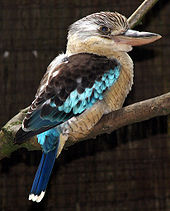| Kookaburra | |
|---|---|
 | |
| Laughing kookaburra in Tasmania, Australia | |
Kookaburras are terrestrial tree kingfishers of the genus Dacelo native to Australiaand New Guinea, which grow to between 28–42 cm (11–17 in) in length. The name is a loanword from Wiradjuri guuguubarra, onomatopoeic of its call. The loud distinctive call of the laughing kookaburra is widely used as a stock sound effect in situations that involve an Australian bush setting.
They are found in habitats ranging from humid forest to arid savanna, as well as in suburban areas with tall trees or near running water. Even though they belong to the larger group known as "kingfishers", kookaburras are not closely associated with water.[2]
They are found in habitats ranging from humid forest to arid savanna, as well as in suburban areas with tall trees or near running water. Even though they belong to the larger group known as "kingfishers", kookaburras are not closely associated with water.[2]Kookaburras are terrestrial tree kingfishers of the genus Dacelo native to Australiaand New Guinea, which grow to between 28–42 cm (11–17 in) in length. The name is a loanword from Wiradjuri guuguubarra, onomatopoeic of its call. The loud distinctive call of the laughing kookaburra is widely used as a stock sound effect in situations that involve an Australian bush setting.
They are found in habitats ranging from humid forest to arid savanna, as well as in suburban areas with tall trees or near running water. Even though they belong to the larger group known as "kingfishers", kookaburras are not closely associated with water.[2]
They are found in habitats ranging from humid forest to arid savanna, as well as in suburban areas with tall trees or near running water. Even though they belong to the larger group known as "kingfishers", kookaburras are not closely associated with water.[2]Kookaburras are terrestrial tree kingfishers of the genus Dacelo native to Australiaand New Guinea, which grow to between 28–42 cm (11–17 in) in length. The name is a loanword from Wiradjuri guuguubarra, onomatopoeic of its call. The loud distinctive call of the laughing kookaburra is widely used as a stock sound effect in situations that involve an Australian bush setting.
Taxonomy[edit]
The genus Dacelo was introduced by the English zoologist William Elford Leach in 1815.[3] The type species is the laughing kookaburra.[4] The name Dacelo is an anagram of Alcedo, the Latin word for a kingfisher.[5] A molecular study published in 2017 found that the genus Dacelo, as currently defined, is paraphyletic. The shovel-billed kookaburra in the monotypic genus Clytoceyx sits within Dacelo.[1]
Classification and species[edit]
Four species of kookaburra can be found in Australia, New Guinea, and the Aru Islands.
Kookaburras are sexually dimorphic. This is noticeable in the blue-winged and the rufous-bellied, where males have blue tails and females have reddish-brown tails.
- Rufous-bellied kookaburra (Dacelo gaudichaud) – lowland New Guinea, Saibai Island and Australia
- Spangled kookaburra (Dacelo tyro) – Aru Islands, southern New Guinea and Australia
- Blue-winged kookaburra (Dacelo leachii) – northern Australia, southern New Guinea
- Laughing kookaburra (Dacelo novaeguineae) – native to eastern Australia, introduced to southwest
-
- Unusually for close relatives, the laughing and blue-winged species are direct competitors in the area where their ranges now overlap.[6] This suggests that these two species evolved in isolation, possibly during a period when Australia and New Guinea were more distant — see Australia (continent).
- The single member of the genus Clytoceyx is commonly called the shovel-billed kookaburra.
Behaviour[edit]
Kookaburras are almost exclusively carnivorous, eating mice, snakes, insects, small reptiles, and the young of other birds; they have also been known to take goldfish from garden ponds. In zoos they are usually fed food for birds of prey.
The most social birds will accept handouts and will take meat from barbecues. It is generally not advised to feed kookaburras ground beef or pet food, as these do not include enough calcium and roughage.[7]
They are territorial, except for the rufous-bellied, which often live with their young from the previous season.[8] They often sing as a chorus to mark their territory.
Conservation[edit]
All kookaburra species are listed as Least Concern. Australian law protects native birds, including kookaburras.
In culture[edit]
The distinctive sound of the laughing kookaburra's call, which sounds like echoing human laughter, is widely used in filmmaking and television productions, as well as certain Disneytheme park attractions, regardless of African, Asian and South American jungle settings. Kookaburras have also appeared in several video games, including (Lineage II, Battletoads, and World of Warcraft) and at least in one short story (Barry Wood's Nowhere to Go).
Olly the Kookaburra was one of the three mascots chosen for the 2000 Summer Olympics in Sydney. The other mascots were Millie the Echidna and Syd the Platypus.
In William Arden's 1969 book, The Mystery of the Laughing Shadow, (one of 'The Three Investigators' series for young readers), the laughing kookaburra is integral to the plot.
The children's television series Splatalot! includes an Australian character called "Kookaburra" (or "Kook"), whose costume includes decorative wings that recall the bird's plumage, and who is noted for his distinctive high-pitched laugh.
It is said that the Kookaburra's call can summon the gods of laughter. But, if you mistreat a Kookaburra, it will upset the gods of laughter, and you will be condemned to an eternity of the inability to laugh.
The call of a kookaburra nicknamed "Jacko" was for many years used as the morning opening theme by ABC radio stations, and for Radio Australia's overseas broadcasts.[9] This was the basis for a book for children:
- Brooke Nicholls; Dorothy Wall (illus.) (1933). Jacko, the Broadcasting Kookaburra — His Life and Adventures. Sydney: Angus & Robertson.





1 comment:
neat
Post a Comment